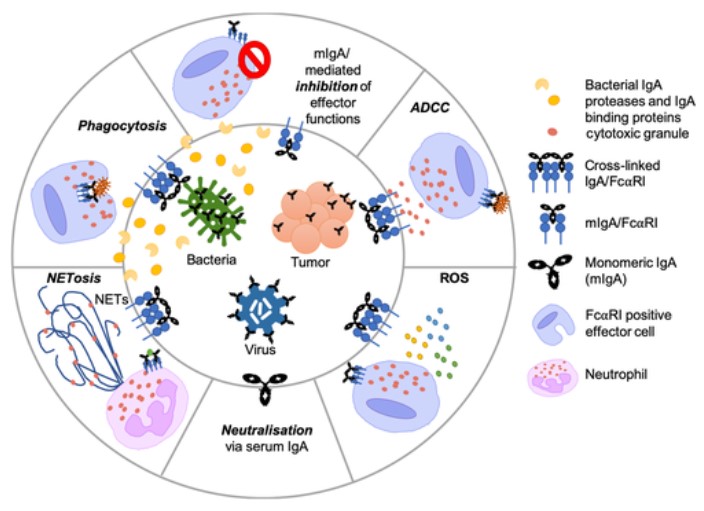IgA Anti-Inflammatory Glycoform Design Service
IgA Anti-Inflammatory Glycoform Design: A Novel Therapeutic Paradigm at Creative Biolabs
Immunoglobulin A (IgA) is a multifaceted antibody, renowned for its crucial role in mucosal immunity where it acts as the first line of defense against invading pathogens. However, IgA's influence extends beyond mucosal surfaces; it also profoundly impacts systemic inflammatory responses. This dual capacity-to maintain immune homeostasis and, conversely, to contribute to pathological inflammation-is intimately linked to its glycosylation profile. At Creative Biolabs, we leverage this intricate relationship through our specialized IgA Anti-Inflammatory Glycoform Design service, aiming to precisely manipulate IgA's carbohydrate structures (glycans) to enhance its inhibitory functions and mitigate pro-inflammatory effects.
IgA molecules are heavily glycosylated, and these attached glycans are not merely structural adornments; they are critical determinants of IgA's effector functions, including its interaction with the FcαRI receptor on immune cells. The binding of IgA to FcαRI can trigger both anti- and pro-inflammatory responses, depending on factors such as IgA concentration, the presence of immune complexes, and crucially, the specific glycan patterns present on the IgA molecule. Modifications to these glycans-such as alterations in sialylation or galactosylation-can significantly impact IgA's affinity for FcαRI, influence the subsequent release of pro-inflammatory cytokines, and ultimately modulate the overall inflammatory cascade. Our service at Creative Biolabs focuses on strategically re-engineering these glycan patterns to unlock IgA's potent anti-inflammatory capabilities.
 Fig.1 Schematic of serum immunoglobulin A (IgA) effector functions.1
Fig.1 Schematic of serum immunoglobulin A (IgA) effector functions.1
Strategic Pillars of Our IgA Anti-Inflammatory Glycoform Design Service
Our comprehensive service strategy at Creative Biolabs is built upon a deep understanding of glycobiology and advanced bioengineering techniques. We meticulously design IgA glycoforms to achieve specific therapeutic outcomes, primarily focused on enhancing their anti-inflammatory properties. This involves a multi-pronged approach that targets key aspects of IgA-mediated immune modulation.
Enhancing Sialylation for Potent Anti-Inflammatory Effects
Sialic acid, a terminal sugar often found on glycans, has been unequivocally demonstrated to mediate anti-inflammatory activity in various antibody classes. Our core strategy involves increasing sialylation, particularly on the Fc region of IgA. This enhanced sialylation has been shown to reduce the binding affinity of IgA to FcαRI, thereby diminishing its ability to activate pro-inflammatory signaling pathways. By mimicking and enhancing the anti-inflammatory effects observed with naturally occurring, highly sialylated IgA, Creative Biolabs engineers IgA molecules that actively dampen inflammation. This precise glycoengineering allows us to generate IgA therapeutics with a higher capacity to modulate immune responses and reduce inflammatory cytokine release, representing a significant advancement in targeted anti-inflammatory therapy.
Targeting ITAMi Signaling with Monomeric IgA
Another critical aspect of our service strategy at Creative Biolabs involves harnessing the immunoregulatory potential of monomeric IgA through its interaction with FcαRI. Monomeric IgA can activate FcαRI and initiate ITAMi (immunoreceptor tyrosine-based inhibition motif) signaling. This inhibitory pathway leads to the recruitment of SHP-1 phosphatase, which, in turn, effectively inhibits pro-inflammatory signaling cascades within immune cells. By designing monomeric IgA glycoforms optimized for ITAMi activation, Creative Biolabs aims to provide a novel therapeutic agent capable of actively dampening inflammation at the cellular level. This targeted approach offers a precise mechanism for controlling immune responses without broadly suppressing the immune system, thereby reducing potential off-target effects.
Advanced Glycoengineering Techniques for Precision and Control
To achieve the desired anti-inflammatory IgA glycoforms, Creative Biolabs employs a suite of sophisticated glycoengineering strategies:
- Enzymatic Glycan Remodeling: We utilize advanced enzymatic techniques, including highly specific enzymes like Endo-S mutants, to precisely remove, add, or modify glycans on IgA. This allows for the creation of specific glycoforms tailored for functional studies and therapeutic development, offering unparalleled control over the glycosylation profile.
- Small Molecule Inhibitors: Our scientists are adept at employing specific small molecule inhibitors to modulate the activity of glycosylation enzymes within producer cells. This method leads to controlled alterations in the overall glycan patterns on IgA, providing another layer of precision in glycoform design.
- Cell-Based Production Systems: We leverage proprietary cell lines with engineered glycosylation machinery to generate IgA with specific, desired glycan structures. This cell-based approach ensures consistent production of therapeutic IgA with the intended anti-inflammatory properties, critical for scaling up and commercialization.
Our Advantages
At Creative Biolabs, our commitment to scientific excellence and therapeutic innovation sets us apart. Our advantages stem from:
- Unrivaled Expertise
- Cutting-Edge Technology
- Tailored Solutions
- Focus on Lead Generation
FAQs
Q1: What is the primary goal of IgA Anti-Inflammatory Glycoform Design?
A1: The primary goal is to engineer IgA antibodies with specific glycan modifications that enhance their anti-inflammatory properties, thereby reducing detrimental immune responses and potentially treating inflammatory and autoimmune diseases.
Q2: How does sialylation influence IgA's anti-inflammatory function?
A2: Increased sialylation, particularly on the Fc region of IgA, reduces the binding affinity of IgA to FcαRI, which in turn downregulates pro-inflammatory signals and promotes an anti-inflammatory state.
Q3: Can IgA glycoengineering be applied to other diseases beyond inflammation?
A3: Yes, while our service focuses on anti-inflammatory applications, the principles of IgA glycoengineering hold promise for other areas. For example, abnormal IgA glycosylation is linked to diseases like IgA nephropathy (IgAN), and modulating these patterns could be a therapeutic strategy. Furthermore, IgA antibodies can be engineered to target tumor cells, with glycosylation modifications influencing their efficacy and pharmacokinetics in cancer therapy.
Contact Us
To learn more about how Creative Biolabs' IgA Anti-Inflammatory Glycoform Design service can accelerate your therapeutic development pipeline, or to discuss your specific research needs, please do not hesitate to contact our expert team. We are ready to partner with you in advancing the next generation of biopharmaceutical solutions.
Reference
- Davis, Samantha K., et al. "Serum IgA Fc effector functions in infectious disease and cancer." Immunology and cell biology 98.4 (2020): 276-286. Distributed under Open Access License CC BY 4.0, without modification.
For research use only. Not intended for any clinical use.
This site is protected by reCAPTCHA and the Google Privacy Policy and Terms of Service apply.

